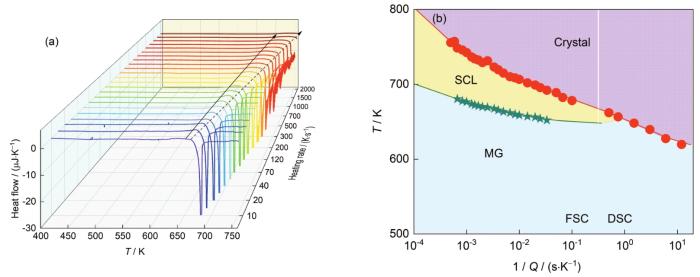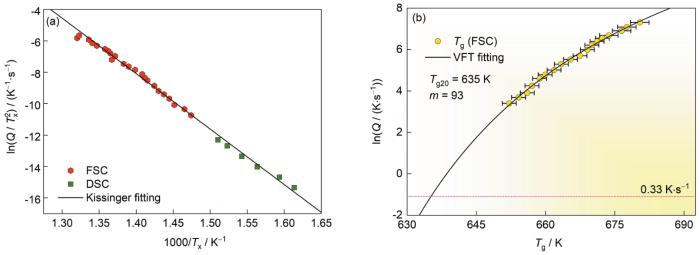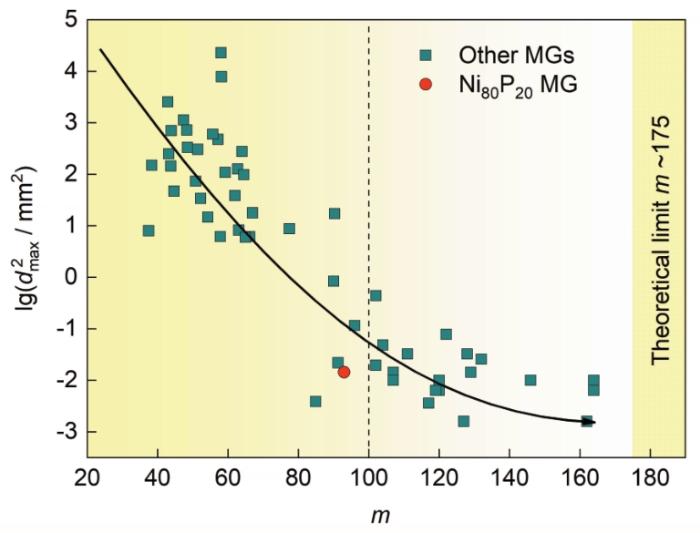Long-range topological order in metallic glass
1
2011
... 金属玻璃,也称为非晶态合金,是一种原子在三维空间中失去了长程有序性和晶格平移对称性而只保持了短程有序的新型金属材料[1~8].和晶态金属材料相比,由于其独特的长程无序、短程有序的原子结构特征,且不存在位错、晶界等传统晶体缺陷,金属玻璃呈现出一系列十分优异的性能,如高强度、高硬度、高耐磨性、高耐腐蚀性以及良好的软磁性能等[2,3,9~21]. ...
Bulk metallic glasses
1
2004
... 金属玻璃,也称为非晶态合金,是一种原子在三维空间中失去了长程有序性和晶格平移对称性而只保持了短程有序的新型金属材料[1~8].和晶态金属材料相比,由于其独特的长程无序、短程有序的原子结构特征,且不存在位错、晶界等传统晶体缺陷,金属玻璃呈现出一系列十分优异的性能,如高强度、高硬度、高耐磨性、高耐腐蚀性以及良好的软磁性能等[2,3,9~21]. ...
Bulk metallic glasses
1
2013
... 金属玻璃,也称为非晶态合金,是一种原子在三维空间中失去了长程有序性和晶格平移对称性而只保持了短程有序的新型金属材料[1~8].和晶态金属材料相比,由于其独特的长程无序、短程有序的原子结构特征,且不存在位错、晶界等传统晶体缺陷,金属玻璃呈现出一系列十分优异的性能,如高强度、高硬度、高耐磨性、高耐腐蚀性以及良好的软磁性能等[2,3,9~21]. ...
Atomic packing and short-to-medium-range order in metallic glasses
1
2006
... Ni-P金属玻璃是金属玻璃中最为经典的成分之一[6,22].早在1950年,Brenner等[23]就采用电沉积的方法制备出Ni-P非晶合金.随后,Ni-P非晶涂层被广泛用于金属表面的防护,这也是非晶合金最早的工业化应用[6].另外,在对非晶合金结构认识过程中,Ni-P金属玻璃也发挥着不可替代的作用[6,22].Bernal于1959年提出了液体和非晶的硬球无规密堆模型[22],随后,Cagill[24]得出结论,认为非晶Ni76P24的实测径向分布函数与硬球无规密堆模型的径向分布函数非常相似,更是证实了硬球无规密堆模型的有效性.Sheng等[4]于2006年提出了非晶合金中以二十面体或类二十面体团簇为主导的准团簇密堆模型,进而提出了非晶合金结构中的“中程序”概念,而该概念的提出也是基于Ni80P20金属玻璃的结构实验数据及分子动力学模拟而进行的.近些年,分子动力学模拟被大量应用于金属玻璃的结构与性能研究,Ni80P20金属玻璃模型仍是研究人员最常用的金属玻璃成分模型[25~28].然而,尽管Ni80P20金属玻璃贯穿了非晶合金研究的整个历程,但人们对其仍不够了解.它具有超差的玻璃形成能力,甩带速率慢一点就能使其发生晶化,也因此,人们至今未探测到其玻璃转变过程. ...
Tuning order in disorder
0
2015
非晶态物质的本质和特性
3
2013
... Ni-P金属玻璃是金属玻璃中最为经典的成分之一[6,22].早在1950年,Brenner等[23]就采用电沉积的方法制备出Ni-P非晶合金.随后,Ni-P非晶涂层被广泛用于金属表面的防护,这也是非晶合金最早的工业化应用[6].另外,在对非晶合金结构认识过程中,Ni-P金属玻璃也发挥着不可替代的作用[6,22].Bernal于1959年提出了液体和非晶的硬球无规密堆模型[22],随后,Cagill[24]得出结论,认为非晶Ni76P24的实测径向分布函数与硬球无规密堆模型的径向分布函数非常相似,更是证实了硬球无规密堆模型的有效性.Sheng等[4]于2006年提出了非晶合金中以二十面体或类二十面体团簇为主导的准团簇密堆模型,进而提出了非晶合金结构中的“中程序”概念,而该概念的提出也是基于Ni80P20金属玻璃的结构实验数据及分子动力学模拟而进行的.近些年,分子动力学模拟被大量应用于金属玻璃的结构与性能研究,Ni80P20金属玻璃模型仍是研究人员最常用的金属玻璃成分模型[25~28].然而,尽管Ni80P20金属玻璃贯穿了非晶合金研究的整个历程,但人们对其仍不够了解.它具有超差的玻璃形成能力,甩带速率慢一点就能使其发生晶化,也因此,人们至今未探测到其玻璃转变过程. ...
... [6].另外,在对非晶合金结构认识过程中,Ni-P金属玻璃也发挥着不可替代的作用[6,22].Bernal于1959年提出了液体和非晶的硬球无规密堆模型[22],随后,Cagill[24]得出结论,认为非晶Ni76P24的实测径向分布函数与硬球无规密堆模型的径向分布函数非常相似,更是证实了硬球无规密堆模型的有效性.Sheng等[4]于2006年提出了非晶合金中以二十面体或类二十面体团簇为主导的准团簇密堆模型,进而提出了非晶合金结构中的“中程序”概念,而该概念的提出也是基于Ni80P20金属玻璃的结构实验数据及分子动力学模拟而进行的.近些年,分子动力学模拟被大量应用于金属玻璃的结构与性能研究,Ni80P20金属玻璃模型仍是研究人员最常用的金属玻璃成分模型[25~28].然而,尽管Ni80P20金属玻璃贯穿了非晶合金研究的整个历程,但人们对其仍不够了解.它具有超差的玻璃形成能力,甩带速率慢一点就能使其发生晶化,也因此,人们至今未探测到其玻璃转变过程. ...
... [6,22].Bernal于1959年提出了液体和非晶的硬球无规密堆模型[22],随后,Cagill[24]得出结论,认为非晶Ni76P24的实测径向分布函数与硬球无规密堆模型的径向分布函数非常相似,更是证实了硬球无规密堆模型的有效性.Sheng等[4]于2006年提出了非晶合金中以二十面体或类二十面体团簇为主导的准团簇密堆模型,进而提出了非晶合金结构中的“中程序”概念,而该概念的提出也是基于Ni80P20金属玻璃的结构实验数据及分子动力学模拟而进行的.近些年,分子动力学模拟被大量应用于金属玻璃的结构与性能研究,Ni80P20金属玻璃模型仍是研究人员最常用的金属玻璃成分模型[25~28].然而,尽管Ni80P20金属玻璃贯穿了非晶合金研究的整个历程,但人们对其仍不够了解.它具有超差的玻璃形成能力,甩带速率慢一点就能使其发生晶化,也因此,人们至今未探测到其玻璃转变过程. ...
非晶态物质的本质和特性
3
2013
... Ni-P金属玻璃是金属玻璃中最为经典的成分之一[6,22].早在1950年,Brenner等[23]就采用电沉积的方法制备出Ni-P非晶合金.随后,Ni-P非晶涂层被广泛用于金属表面的防护,这也是非晶合金最早的工业化应用[6].另外,在对非晶合金结构认识过程中,Ni-P金属玻璃也发挥着不可替代的作用[6,22].Bernal于1959年提出了液体和非晶的硬球无规密堆模型[22],随后,Cagill[24]得出结论,认为非晶Ni76P24的实测径向分布函数与硬球无规密堆模型的径向分布函数非常相似,更是证实了硬球无规密堆模型的有效性.Sheng等[4]于2006年提出了非晶合金中以二十面体或类二十面体团簇为主导的准团簇密堆模型,进而提出了非晶合金结构中的“中程序”概念,而该概念的提出也是基于Ni80P20金属玻璃的结构实验数据及分子动力学模拟而进行的.近些年,分子动力学模拟被大量应用于金属玻璃的结构与性能研究,Ni80P20金属玻璃模型仍是研究人员最常用的金属玻璃成分模型[25~28].然而,尽管Ni80P20金属玻璃贯穿了非晶合金研究的整个历程,但人们对其仍不够了解.它具有超差的玻璃形成能力,甩带速率慢一点就能使其发生晶化,也因此,人们至今未探测到其玻璃转变过程. ...
... [6].另外,在对非晶合金结构认识过程中,Ni-P金属玻璃也发挥着不可替代的作用[6,22].Bernal于1959年提出了液体和非晶的硬球无规密堆模型[22],随后,Cagill[24]得出结论,认为非晶Ni76P24的实测径向分布函数与硬球无规密堆模型的径向分布函数非常相似,更是证实了硬球无规密堆模型的有效性.Sheng等[4]于2006年提出了非晶合金中以二十面体或类二十面体团簇为主导的准团簇密堆模型,进而提出了非晶合金结构中的“中程序”概念,而该概念的提出也是基于Ni80P20金属玻璃的结构实验数据及分子动力学模拟而进行的.近些年,分子动力学模拟被大量应用于金属玻璃的结构与性能研究,Ni80P20金属玻璃模型仍是研究人员最常用的金属玻璃成分模型[25~28].然而,尽管Ni80P20金属玻璃贯穿了非晶合金研究的整个历程,但人们对其仍不够了解.它具有超差的玻璃形成能力,甩带速率慢一点就能使其发生晶化,也因此,人们至今未探测到其玻璃转变过程. ...
... [6,22].Bernal于1959年提出了液体和非晶的硬球无规密堆模型[22],随后,Cagill[24]得出结论,认为非晶Ni76P24的实测径向分布函数与硬球无规密堆模型的径向分布函数非常相似,更是证实了硬球无规密堆模型的有效性.Sheng等[4]于2006年提出了非晶合金中以二十面体或类二十面体团簇为主导的准团簇密堆模型,进而提出了非晶合金结构中的“中程序”概念,而该概念的提出也是基于Ni80P20金属玻璃的结构实验数据及分子动力学模拟而进行的.近些年,分子动力学模拟被大量应用于金属玻璃的结构与性能研究,Ni80P20金属玻璃模型仍是研究人员最常用的金属玻璃成分模型[25~28].然而,尽管Ni80P20金属玻璃贯穿了非晶合金研究的整个历程,但人们对其仍不够了解.它具有超差的玻璃形成能力,甩带速率慢一点就能使其发生晶化,也因此,人们至今未探测到其玻璃转变过程. ...
Direct observation of local atomic order in a metallic glass
0
2011
Atomic-level structure and structure-property relationship in metallic glasses
1
2011
... 金属玻璃,也称为非晶态合金,是一种原子在三维空间中失去了长程有序性和晶格平移对称性而只保持了短程有序的新型金属材料[1~8].和晶态金属材料相比,由于其独特的长程无序、短程有序的原子结构特征,且不存在位错、晶界等传统晶体缺陷,金属玻璃呈现出一系列十分优异的性能,如高强度、高硬度、高耐磨性、高耐腐蚀性以及良好的软磁性能等[2,3,9~21]. ...
Bulk metallic glass: The smaller the better
1
2011
... 金属玻璃,也称为非晶态合金,是一种原子在三维空间中失去了长程有序性和晶格平移对称性而只保持了短程有序的新型金属材料[1~8].和晶态金属材料相比,由于其独特的长程无序、短程有序的原子结构特征,且不存在位错、晶界等传统晶体缺陷,金属玻璃呈现出一系列十分优异的性能,如高强度、高硬度、高耐磨性、高耐腐蚀性以及良好的软磁性能等[2,3,9~21]. ...
Bulk glass-forming metallic alloys: Science and technology
0
1999
Iron-based bulk metallic glasses
0
2013
Bulk metallic glasses with functional physical properties
0
2009
Bulk metallic glasses
0
2004
Metallic glasses...on the threshold
0
2009
Bulk glass-forming metallic alloys: Science and technology
0
1999
Mechanical behavior of amorphous alloys
0
2007
Fe-based bulk metallic glasses: Glass formation, fabrication, properties and applications
0
2019
金属玻璃中隐藏在长时间尺度下的动力学行为及其对性能的影响
0
2018
金属玻璃中隐藏在长时间尺度下的动力学行为及其对性能的影响
0
2018
Zr-(Cu, Ag)-Al bulk metallic glasses
0
2008
Low-density high-strength bulk metallic glasses and their composites: A review
1
2015
... 金属玻璃,也称为非晶态合金,是一种原子在三维空间中失去了长程有序性和晶格平移对称性而只保持了短程有序的新型金属材料[1~8].和晶态金属材料相比,由于其独特的长程无序、短程有序的原子结构特征,且不存在位错、晶界等传统晶体缺陷,金属玻璃呈现出一系列十分优异的性能,如高强度、高硬度、高耐磨性、高耐腐蚀性以及良好的软磁性能等[2,3,9~21]. ...
3
1989
... Ni-P金属玻璃是金属玻璃中最为经典的成分之一[6,22].早在1950年,Brenner等[23]就采用电沉积的方法制备出Ni-P非晶合金.随后,Ni-P非晶涂层被广泛用于金属表面的防护,这也是非晶合金最早的工业化应用[6].另外,在对非晶合金结构认识过程中,Ni-P金属玻璃也发挥着不可替代的作用[6,22].Bernal于1959年提出了液体和非晶的硬球无规密堆模型[22],随后,Cagill[24]得出结论,认为非晶Ni76P24的实测径向分布函数与硬球无规密堆模型的径向分布函数非常相似,更是证实了硬球无规密堆模型的有效性.Sheng等[4]于2006年提出了非晶合金中以二十面体或类二十面体团簇为主导的准团簇密堆模型,进而提出了非晶合金结构中的“中程序”概念,而该概念的提出也是基于Ni80P20金属玻璃的结构实验数据及分子动力学模拟而进行的.近些年,分子动力学模拟被大量应用于金属玻璃的结构与性能研究,Ni80P20金属玻璃模型仍是研究人员最常用的金属玻璃成分模型[25~28].然而,尽管Ni80P20金属玻璃贯穿了非晶合金研究的整个历程,但人们对其仍不够了解.它具有超差的玻璃形成能力,甩带速率慢一点就能使其发生晶化,也因此,人们至今未探测到其玻璃转变过程. ...
... ,22].Bernal于1959年提出了液体和非晶的硬球无规密堆模型[22],随后,Cagill[24]得出结论,认为非晶Ni76P24的实测径向分布函数与硬球无规密堆模型的径向分布函数非常相似,更是证实了硬球无规密堆模型的有效性.Sheng等[4]于2006年提出了非晶合金中以二十面体或类二十面体团簇为主导的准团簇密堆模型,进而提出了非晶合金结构中的“中程序”概念,而该概念的提出也是基于Ni80P20金属玻璃的结构实验数据及分子动力学模拟而进行的.近些年,分子动力学模拟被大量应用于金属玻璃的结构与性能研究,Ni80P20金属玻璃模型仍是研究人员最常用的金属玻璃成分模型[25~28].然而,尽管Ni80P20金属玻璃贯穿了非晶合金研究的整个历程,但人们对其仍不够了解.它具有超差的玻璃形成能力,甩带速率慢一点就能使其发生晶化,也因此,人们至今未探测到其玻璃转变过程. ...
... [22],随后,Cagill[24]得出结论,认为非晶Ni76P24的实测径向分布函数与硬球无规密堆模型的径向分布函数非常相似,更是证实了硬球无规密堆模型的有效性.Sheng等[4]于2006年提出了非晶合金中以二十面体或类二十面体团簇为主导的准团簇密堆模型,进而提出了非晶合金结构中的“中程序”概念,而该概念的提出也是基于Ni80P20金属玻璃的结构实验数据及分子动力学模拟而进行的.近些年,分子动力学模拟被大量应用于金属玻璃的结构与性能研究,Ni80P20金属玻璃模型仍是研究人员最常用的金属玻璃成分模型[25~28].然而,尽管Ni80P20金属玻璃贯穿了非晶合金研究的整个历程,但人们对其仍不够了解.它具有超差的玻璃形成能力,甩带速率慢一点就能使其发生晶化,也因此,人们至今未探测到其玻璃转变过程. ...
3
1989
... Ni-P金属玻璃是金属玻璃中最为经典的成分之一[6,22].早在1950年,Brenner等[23]就采用电沉积的方法制备出Ni-P非晶合金.随后,Ni-P非晶涂层被广泛用于金属表面的防护,这也是非晶合金最早的工业化应用[6].另外,在对非晶合金结构认识过程中,Ni-P金属玻璃也发挥着不可替代的作用[6,22].Bernal于1959年提出了液体和非晶的硬球无规密堆模型[22],随后,Cagill[24]得出结论,认为非晶Ni76P24的实测径向分布函数与硬球无规密堆模型的径向分布函数非常相似,更是证实了硬球无规密堆模型的有效性.Sheng等[4]于2006年提出了非晶合金中以二十面体或类二十面体团簇为主导的准团簇密堆模型,进而提出了非晶合金结构中的“中程序”概念,而该概念的提出也是基于Ni80P20金属玻璃的结构实验数据及分子动力学模拟而进行的.近些年,分子动力学模拟被大量应用于金属玻璃的结构与性能研究,Ni80P20金属玻璃模型仍是研究人员最常用的金属玻璃成分模型[25~28].然而,尽管Ni80P20金属玻璃贯穿了非晶合金研究的整个历程,但人们对其仍不够了解.它具有超差的玻璃形成能力,甩带速率慢一点就能使其发生晶化,也因此,人们至今未探测到其玻璃转变过程. ...
... ,22].Bernal于1959年提出了液体和非晶的硬球无规密堆模型[22],随后,Cagill[24]得出结论,认为非晶Ni76P24的实测径向分布函数与硬球无规密堆模型的径向分布函数非常相似,更是证实了硬球无规密堆模型的有效性.Sheng等[4]于2006年提出了非晶合金中以二十面体或类二十面体团簇为主导的准团簇密堆模型,进而提出了非晶合金结构中的“中程序”概念,而该概念的提出也是基于Ni80P20金属玻璃的结构实验数据及分子动力学模拟而进行的.近些年,分子动力学模拟被大量应用于金属玻璃的结构与性能研究,Ni80P20金属玻璃模型仍是研究人员最常用的金属玻璃成分模型[25~28].然而,尽管Ni80P20金属玻璃贯穿了非晶合金研究的整个历程,但人们对其仍不够了解.它具有超差的玻璃形成能力,甩带速率慢一点就能使其发生晶化,也因此,人们至今未探测到其玻璃转变过程. ...
... [22],随后,Cagill[24]得出结论,认为非晶Ni76P24的实测径向分布函数与硬球无规密堆模型的径向分布函数非常相似,更是证实了硬球无规密堆模型的有效性.Sheng等[4]于2006年提出了非晶合金中以二十面体或类二十面体团簇为主导的准团簇密堆模型,进而提出了非晶合金结构中的“中程序”概念,而该概念的提出也是基于Ni80P20金属玻璃的结构实验数据及分子动力学模拟而进行的.近些年,分子动力学模拟被大量应用于金属玻璃的结构与性能研究,Ni80P20金属玻璃模型仍是研究人员最常用的金属玻璃成分模型[25~28].然而,尽管Ni80P20金属玻璃贯穿了非晶合金研究的整个历程,但人们对其仍不够了解.它具有超差的玻璃形成能力,甩带速率慢一点就能使其发生晶化,也因此,人们至今未探测到其玻璃转变过程. ...
Electrodeposition of alloys of phosphorus with nickel or cobalt
1
1950
... Ni-P金属玻璃是金属玻璃中最为经典的成分之一[6,22].早在1950年,Brenner等[23]就采用电沉积的方法制备出Ni-P非晶合金.随后,Ni-P非晶涂层被广泛用于金属表面的防护,这也是非晶合金最早的工业化应用[6].另外,在对非晶合金结构认识过程中,Ni-P金属玻璃也发挥着不可替代的作用[6,22].Bernal于1959年提出了液体和非晶的硬球无规密堆模型[22],随后,Cagill[24]得出结论,认为非晶Ni76P24的实测径向分布函数与硬球无规密堆模型的径向分布函数非常相似,更是证实了硬球无规密堆模型的有效性.Sheng等[4]于2006年提出了非晶合金中以二十面体或类二十面体团簇为主导的准团簇密堆模型,进而提出了非晶合金结构中的“中程序”概念,而该概念的提出也是基于Ni80P20金属玻璃的结构实验数据及分子动力学模拟而进行的.近些年,分子动力学模拟被大量应用于金属玻璃的结构与性能研究,Ni80P20金属玻璃模型仍是研究人员最常用的金属玻璃成分模型[25~28].然而,尽管Ni80P20金属玻璃贯穿了非晶合金研究的整个历程,但人们对其仍不够了解.它具有超差的玻璃形成能力,甩带速率慢一点就能使其发生晶化,也因此,人们至今未探测到其玻璃转变过程. ...
Structural investigation of noncrystalline nickel-phosphorus alloys
1
1970
... Ni-P金属玻璃是金属玻璃中最为经典的成分之一[6,22].早在1950年,Brenner等[23]就采用电沉积的方法制备出Ni-P非晶合金.随后,Ni-P非晶涂层被广泛用于金属表面的防护,这也是非晶合金最早的工业化应用[6].另外,在对非晶合金结构认识过程中,Ni-P金属玻璃也发挥着不可替代的作用[6,22].Bernal于1959年提出了液体和非晶的硬球无规密堆模型[22],随后,Cagill[24]得出结论,认为非晶Ni76P24的实测径向分布函数与硬球无规密堆模型的径向分布函数非常相似,更是证实了硬球无规密堆模型的有效性.Sheng等[4]于2006年提出了非晶合金中以二十面体或类二十面体团簇为主导的准团簇密堆模型,进而提出了非晶合金结构中的“中程序”概念,而该概念的提出也是基于Ni80P20金属玻璃的结构实验数据及分子动力学模拟而进行的.近些年,分子动力学模拟被大量应用于金属玻璃的结构与性能研究,Ni80P20金属玻璃模型仍是研究人员最常用的金属玻璃成分模型[25~28].然而,尽管Ni80P20金属玻璃贯穿了非晶合金研究的整个历程,但人们对其仍不够了解.它具有超差的玻璃形成能力,甩带速率慢一点就能使其发生晶化,也因此,人们至今未探测到其玻璃转变过程. ...
Structural rearrangements governing Johari-Goldstein relaxations in metallic glasses
1
2017
... Ni-P金属玻璃是金属玻璃中最为经典的成分之一[6,22].早在1950年,Brenner等[23]就采用电沉积的方法制备出Ni-P非晶合金.随后,Ni-P非晶涂层被广泛用于金属表面的防护,这也是非晶合金最早的工业化应用[6].另外,在对非晶合金结构认识过程中,Ni-P金属玻璃也发挥着不可替代的作用[6,22].Bernal于1959年提出了液体和非晶的硬球无规密堆模型[22],随后,Cagill[24]得出结论,认为非晶Ni76P24的实测径向分布函数与硬球无规密堆模型的径向分布函数非常相似,更是证实了硬球无规密堆模型的有效性.Sheng等[4]于2006年提出了非晶合金中以二十面体或类二十面体团簇为主导的准团簇密堆模型,进而提出了非晶合金结构中的“中程序”概念,而该概念的提出也是基于Ni80P20金属玻璃的结构实验数据及分子动力学模拟而进行的.近些年,分子动力学模拟被大量应用于金属玻璃的结构与性能研究,Ni80P20金属玻璃模型仍是研究人员最常用的金属玻璃成分模型[25~28].然而,尽管Ni80P20金属玻璃贯穿了非晶合金研究的整个历程,但人们对其仍不够了解.它具有超差的玻璃形成能力,甩带速率慢一点就能使其发生晶化,也因此,人们至今未探测到其玻璃转变过程. ...
Fundamental link between β relaxation, excess wings, and cage-breaking in metallic glasses
0
2018
Structural origin for vibration-induced accelerated aging and rejuvenation in metallic glasses
0
2019
Unified criterion for temperature-induced and strain-driven glass transitions in metallic glass
1
2015
... Ni-P金属玻璃是金属玻璃中最为经典的成分之一[6,22].早在1950年,Brenner等[23]就采用电沉积的方法制备出Ni-P非晶合金.随后,Ni-P非晶涂层被广泛用于金属表面的防护,这也是非晶合金最早的工业化应用[6].另外,在对非晶合金结构认识过程中,Ni-P金属玻璃也发挥着不可替代的作用[6,22].Bernal于1959年提出了液体和非晶的硬球无规密堆模型[22],随后,Cagill[24]得出结论,认为非晶Ni76P24的实测径向分布函数与硬球无规密堆模型的径向分布函数非常相似,更是证实了硬球无规密堆模型的有效性.Sheng等[4]于2006年提出了非晶合金中以二十面体或类二十面体团簇为主导的准团簇密堆模型,进而提出了非晶合金结构中的“中程序”概念,而该概念的提出也是基于Ni80P20金属玻璃的结构实验数据及分子动力学模拟而进行的.近些年,分子动力学模拟被大量应用于金属玻璃的结构与性能研究,Ni80P20金属玻璃模型仍是研究人员最常用的金属玻璃成分模型[25~28].然而,尽管Ni80P20金属玻璃贯穿了非晶合金研究的整个历程,但人们对其仍不够了解.它具有超差的玻璃形成能力,甩带速率慢一点就能使其发生晶化,也因此,人们至今未探测到其玻璃转变过程. ...
Formation of glasses from liquids and biopolymers
1
1995
... 玻璃通常被认为是冻结的液体,因此玻璃的性质很大程度上遗传自液体的性质,要想了解金属玻璃的玻璃形成能力,研究其液体的性质或许是一个很好的途径.1990年,Angell[29]引入“脆度”的概念来描述液体的性质(如黏度、扩散和弛豫时间)随温度变化时偏离Arrhenius关系的程度.液体性质随温度变化越偏离Arrhenius关系,则液体越“脆”;越接近Arrhenius关系,则液体越“强”.许多研究[30~36]已经发现,金属玻璃的玻璃形成能力和液体的脆度密切相关.最近科研人员[30,32,33]通过脆度指数和Turnbull参数将金属玻璃的玻璃形成能力进行定量比较.Ni80P20金属玻璃的过冷液体由于其稳定性差,在常规升温速率下加热时,玻璃转变没开始就被晶化过程所阻断,所以至今不能探测到其过冷液体,这也为研究过冷液体性质带来了困难. ...
Quantifying the origin of metallic glass formation
4
2016
... 玻璃通常被认为是冻结的液体,因此玻璃的性质很大程度上遗传自液体的性质,要想了解金属玻璃的玻璃形成能力,研究其液体的性质或许是一个很好的途径.1990年,Angell[29]引入“脆度”的概念来描述液体的性质(如黏度、扩散和弛豫时间)随温度变化时偏离Arrhenius关系的程度.液体性质随温度变化越偏离Arrhenius关系,则液体越“脆”;越接近Arrhenius关系,则液体越“强”.许多研究[30~36]已经发现,金属玻璃的玻璃形成能力和液体的脆度密切相关.最近科研人员[30,32,33]通过脆度指数和Turnbull参数将金属玻璃的玻璃形成能力进行定量比较.Ni80P20金属玻璃的过冷液体由于其稳定性差,在常规升温速率下加热时,玻璃转变没开始就被晶化过程所阻断,所以至今不能探测到其过冷液体,这也为研究过冷液体性质带来了困难. ...
... [30,32,33]通过脆度指数和Turnbull参数将金属玻璃的玻璃形成能力进行定量比较.Ni80P20金属玻璃的过冷液体由于其稳定性差,在常规升温速率下加热时,玻璃转变没开始就被晶化过程所阻断,所以至今不能探测到其过冷液体,这也为研究过冷液体性质带来了困难. ...
... 图3a总结了Ni80P20金属玻璃晶化的Kissinger图.Kissinger方程的形式为ln(Q/Tx2) = -(Ex/(RTx))+A,式中,R为理想气体常数,Ex为晶化激活能,A为常数.通过Kissinger方程进行拟合得到Ex =303 kJ/mol,需要注意的是,低升温速率范围的数据点来自于常规热分析测量,而超过5 K/s升温速率的晶化温度数据点则来自超快热分析数据.发现常规热分析测量的数据点和超快热分析测量的数据点之间有着很好的衔接,这说明Ni80P20金属玻璃的晶化过程并没有因为升温速率的大幅提高而发生本质的改变,仅仅是晶化温度被延迟到更高的温度.基于不同升温速率下玻璃转变温度的依赖关系,Vogel-Fulcher-Tammann (VFT)方程可以被写为Q = Q0exp(D*T0/(Tg - T0))[32,37~39],式中,Q0为升温速率维度的拟合参数,D*是强度参数,T0是加热速率极度慢的极限下Tg的外推温度,Tg对应于不同升温速率下的玻璃转变温度.液体脆度m = D*T0Tg20 / ((Tg20 - T0)2ln10)[38,40],其中,Tg20为升温速率20 K/min下的玻璃转变温度.需要特别注意的是,由于Ni80P20金属玻璃在20 K/min加热速率下的玻璃转变不能被常规热分析仪探测到,因此本工作中Tg20=635.8 K是通过高升温速率下的Tg进行外推得到的.如图3b所示,Ni80P20金属玻璃的液体脆度通过VFT方程拟合得到,其液体脆度m = 93 ± 4,因此Ni80P20金属玻璃的过冷液体展现出相比于大部分锆基、稀土基、镁基和钯基等大块金属玻璃液体(一般m < 60)更明显的一种“脆”性的液体行为[30,41]. ...
... 图5总结了典型金属玻璃的液体脆度和玻璃形成能力的数据,其中dmax被定义为形成完全非晶态棒状金属玻璃的最大直径,它们的液体脆度值跨越了低于理论极限允许下的整个脆度范围.根据Johnson等[30]的报道,Ni80P20金属玻璃的dmax = 0.12 mm,可以看到Ni80P20金属玻璃很好地符合了液体脆度和玻璃形成能力之间的关系[32].同时,注意到大部分具有很好玻璃形成能力的块体金属玻璃的液体脆度一般小于60,这表明Ni80P20金属玻璃具有较差的玻璃形成能力的主要原因是其相对高的液体脆度值. ...
Correlation between fragility and glass-forming ability of metallic alloys
0
2007
Revealing hidden supercooled liquid states in Al-based metallic glasses by ultrafast scanning calorimetry: Approaching theoretical ceiling of liquid fragility
3
2020
... 玻璃通常被认为是冻结的液体,因此玻璃的性质很大程度上遗传自液体的性质,要想了解金属玻璃的玻璃形成能力,研究其液体的性质或许是一个很好的途径.1990年,Angell[29]引入“脆度”的概念来描述液体的性质(如黏度、扩散和弛豫时间)随温度变化时偏离Arrhenius关系的程度.液体性质随温度变化越偏离Arrhenius关系,则液体越“脆”;越接近Arrhenius关系,则液体越“强”.许多研究[30~36]已经发现,金属玻璃的玻璃形成能力和液体的脆度密切相关.最近科研人员[30,32,33]通过脆度指数和Turnbull参数将金属玻璃的玻璃形成能力进行定量比较.Ni80P20金属玻璃的过冷液体由于其稳定性差,在常规升温速率下加热时,玻璃转变没开始就被晶化过程所阻断,所以至今不能探测到其过冷液体,这也为研究过冷液体性质带来了困难. ...
... 图3a总结了Ni80P20金属玻璃晶化的Kissinger图.Kissinger方程的形式为ln(Q/Tx2) = -(Ex/(RTx))+A,式中,R为理想气体常数,Ex为晶化激活能,A为常数.通过Kissinger方程进行拟合得到Ex =303 kJ/mol,需要注意的是,低升温速率范围的数据点来自于常规热分析测量,而超过5 K/s升温速率的晶化温度数据点则来自超快热分析数据.发现常规热分析测量的数据点和超快热分析测量的数据点之间有着很好的衔接,这说明Ni80P20金属玻璃的晶化过程并没有因为升温速率的大幅提高而发生本质的改变,仅仅是晶化温度被延迟到更高的温度.基于不同升温速率下玻璃转变温度的依赖关系,Vogel-Fulcher-Tammann (VFT)方程可以被写为Q = Q0exp(D*T0/(Tg - T0))[32,37~39],式中,Q0为升温速率维度的拟合参数,D*是强度参数,T0是加热速率极度慢的极限下Tg的外推温度,Tg对应于不同升温速率下的玻璃转变温度.液体脆度m = D*T0Tg20 / ((Tg20 - T0)2ln10)[38,40],其中,Tg20为升温速率20 K/min下的玻璃转变温度.需要特别注意的是,由于Ni80P20金属玻璃在20 K/min加热速率下的玻璃转变不能被常规热分析仪探测到,因此本工作中Tg20=635.8 K是通过高升温速率下的Tg进行外推得到的.如图3b所示,Ni80P20金属玻璃的液体脆度通过VFT方程拟合得到,其液体脆度m = 93 ± 4,因此Ni80P20金属玻璃的过冷液体展现出相比于大部分锆基、稀土基、镁基和钯基等大块金属玻璃液体(一般m < 60)更明显的一种“脆”性的液体行为[30,41]. ...
... 图5总结了典型金属玻璃的液体脆度和玻璃形成能力的数据,其中dmax被定义为形成完全非晶态棒状金属玻璃的最大直径,它们的液体脆度值跨越了低于理论极限允许下的整个脆度范围.根据Johnson等[30]的报道,Ni80P20金属玻璃的dmax = 0.12 mm,可以看到Ni80P20金属玻璃很好地符合了液体脆度和玻璃形成能力之间的关系[32].同时,注意到大部分具有很好玻璃形成能力的块体金属玻璃的液体脆度一般小于60,这表明Ni80P20金属玻璃具有较差的玻璃形成能力的主要原因是其相对高的液体脆度值. ...
Link between volume, thermal expansion, and bulk metallic glass formability
1
2020
... 玻璃通常被认为是冻结的液体,因此玻璃的性质很大程度上遗传自液体的性质,要想了解金属玻璃的玻璃形成能力,研究其液体的性质或许是一个很好的途径.1990年,Angell[29]引入“脆度”的概念来描述液体的性质(如黏度、扩散和弛豫时间)随温度变化时偏离Arrhenius关系的程度.液体性质随温度变化越偏离Arrhenius关系,则液体越“脆”;越接近Arrhenius关系,则液体越“强”.许多研究[30~36]已经发现,金属玻璃的玻璃形成能力和液体的脆度密切相关.最近科研人员[30,32,33]通过脆度指数和Turnbull参数将金属玻璃的玻璃形成能力进行定量比较.Ni80P20金属玻璃的过冷液体由于其稳定性差,在常规升温速率下加热时,玻璃转变没开始就被晶化过程所阻断,所以至今不能探测到其过冷液体,这也为研究过冷液体性质带来了困难. ...
A “universal” criterion for metallic glass formation
0
2012
Poor glass-forming ability of Fe-based alloys: Its origin in high-temperature melt dynamics
0
2017
Fragility of superheated melts and glass-forming ability in Al-based alloys
1
2005
... 玻璃通常被认为是冻结的液体,因此玻璃的性质很大程度上遗传自液体的性质,要想了解金属玻璃的玻璃形成能力,研究其液体的性质或许是一个很好的途径.1990年,Angell[29]引入“脆度”的概念来描述液体的性质(如黏度、扩散和弛豫时间)随温度变化时偏离Arrhenius关系的程度.液体性质随温度变化越偏离Arrhenius关系,则液体越“脆”;越接近Arrhenius关系,则液体越“强”.许多研究[30~36]已经发现,金属玻璃的玻璃形成能力和液体的脆度密切相关.最近科研人员[30,32,33]通过脆度指数和Turnbull参数将金属玻璃的玻璃形成能力进行定量比较.Ni80P20金属玻璃的过冷液体由于其稳定性差,在常规升温速率下加热时,玻璃转变没开始就被晶化过程所阻断,所以至今不能探测到其过冷液体,这也为研究过冷液体性质带来了困难. ...
Understanding glass through differential scanning calorimetry
1
2019
... 图3a总结了Ni80P20金属玻璃晶化的Kissinger图.Kissinger方程的形式为ln(Q/Tx2) = -(Ex/(RTx))+A,式中,R为理想气体常数,Ex为晶化激活能,A为常数.通过Kissinger方程进行拟合得到Ex =303 kJ/mol,需要注意的是,低升温速率范围的数据点来自于常规热分析测量,而超过5 K/s升温速率的晶化温度数据点则来自超快热分析数据.发现常规热分析测量的数据点和超快热分析测量的数据点之间有着很好的衔接,这说明Ni80P20金属玻璃的晶化过程并没有因为升温速率的大幅提高而发生本质的改变,仅仅是晶化温度被延迟到更高的温度.基于不同升温速率下玻璃转变温度的依赖关系,Vogel-Fulcher-Tammann (VFT)方程可以被写为Q = Q0exp(D*T0/(Tg - T0))[32,37~39],式中,Q0为升温速率维度的拟合参数,D*是强度参数,T0是加热速率极度慢的极限下Tg的外推温度,Tg对应于不同升温速率下的玻璃转变温度.液体脆度m = D*T0Tg20 / ((Tg20 - T0)2ln10)[38,40],其中,Tg20为升温速率20 K/min下的玻璃转变温度.需要特别注意的是,由于Ni80P20金属玻璃在20 K/min加热速率下的玻璃转变不能被常规热分析仪探测到,因此本工作中Tg20=635.8 K是通过高升温速率下的Tg进行外推得到的.如图3b所示,Ni80P20金属玻璃的液体脆度通过VFT方程拟合得到,其液体脆度m = 93 ± 4,因此Ni80P20金属玻璃的过冷液体展现出相比于大部分锆基、稀土基、镁基和钯基等大块金属玻璃液体(一般m < 60)更明显的一种“脆”性的液体行为[30,41]. ...
Evaluating the correlation between liquid fragility and glass-forming ability in the extremely strong Ce-based bulk metallic glasses
1
2017
... 图3a总结了Ni80P20金属玻璃晶化的Kissinger图.Kissinger方程的形式为ln(Q/Tx2) = -(Ex/(RTx))+A,式中,R为理想气体常数,Ex为晶化激活能,A为常数.通过Kissinger方程进行拟合得到Ex =303 kJ/mol,需要注意的是,低升温速率范围的数据点来自于常规热分析测量,而超过5 K/s升温速率的晶化温度数据点则来自超快热分析数据.发现常规热分析测量的数据点和超快热分析测量的数据点之间有着很好的衔接,这说明Ni80P20金属玻璃的晶化过程并没有因为升温速率的大幅提高而发生本质的改变,仅仅是晶化温度被延迟到更高的温度.基于不同升温速率下玻璃转变温度的依赖关系,Vogel-Fulcher-Tammann (VFT)方程可以被写为Q = Q0exp(D*T0/(Tg - T0))[32,37~39],式中,Q0为升温速率维度的拟合参数,D*是强度参数,T0是加热速率极度慢的极限下Tg的外推温度,Tg对应于不同升温速率下的玻璃转变温度.液体脆度m = D*T0Tg20 / ((Tg20 - T0)2ln10)[38,40],其中,Tg20为升温速率20 K/min下的玻璃转变温度.需要特别注意的是,由于Ni80P20金属玻璃在20 K/min加热速率下的玻璃转变不能被常规热分析仪探测到,因此本工作中Tg20=635.8 K是通过高升温速率下的Tg进行外推得到的.如图3b所示,Ni80P20金属玻璃的液体脆度通过VFT方程拟合得到,其液体脆度m = 93 ± 4,因此Ni80P20金属玻璃的过冷液体展现出相比于大部分锆基、稀土基、镁基和钯基等大块金属玻璃液体(一般m < 60)更明显的一种“脆”性的液体行为[30,41]. ...
Glass transition on long time scales
1
1992
... 图3a总结了Ni80P20金属玻璃晶化的Kissinger图.Kissinger方程的形式为ln(Q/Tx2) = -(Ex/(RTx))+A,式中,R为理想气体常数,Ex为晶化激活能,A为常数.通过Kissinger方程进行拟合得到Ex =303 kJ/mol,需要注意的是,低升温速率范围的数据点来自于常规热分析测量,而超过5 K/s升温速率的晶化温度数据点则来自超快热分析数据.发现常规热分析测量的数据点和超快热分析测量的数据点之间有着很好的衔接,这说明Ni80P20金属玻璃的晶化过程并没有因为升温速率的大幅提高而发生本质的改变,仅仅是晶化温度被延迟到更高的温度.基于不同升温速率下玻璃转变温度的依赖关系,Vogel-Fulcher-Tammann (VFT)方程可以被写为Q = Q0exp(D*T0/(Tg - T0))[32,37~39],式中,Q0为升温速率维度的拟合参数,D*是强度参数,T0是加热速率极度慢的极限下Tg的外推温度,Tg对应于不同升温速率下的玻璃转变温度.液体脆度m = D*T0Tg20 / ((Tg20 - T0)2ln10)[38,40],其中,Tg20为升温速率20 K/min下的玻璃转变温度.需要特别注意的是,由于Ni80P20金属玻璃在20 K/min加热速率下的玻璃转变不能被常规热分析仪探测到,因此本工作中Tg20=635.8 K是通过高升温速率下的Tg进行外推得到的.如图3b所示,Ni80P20金属玻璃的液体脆度通过VFT方程拟合得到,其液体脆度m = 93 ± 4,因此Ni80P20金属玻璃的过冷液体展现出相比于大部分锆基、稀土基、镁基和钯基等大块金属玻璃液体(一般m < 60)更明显的一种“脆”性的液体行为[30,41]. ...
Nonexponential relaxations in strong and fragile glass formers
1
1993
... 图3a总结了Ni80P20金属玻璃晶化的Kissinger图.Kissinger方程的形式为ln(Q/Tx2) = -(Ex/(RTx))+A,式中,R为理想气体常数,Ex为晶化激活能,A为常数.通过Kissinger方程进行拟合得到Ex =303 kJ/mol,需要注意的是,低升温速率范围的数据点来自于常规热分析测量,而超过5 K/s升温速率的晶化温度数据点则来自超快热分析数据.发现常规热分析测量的数据点和超快热分析测量的数据点之间有着很好的衔接,这说明Ni80P20金属玻璃的晶化过程并没有因为升温速率的大幅提高而发生本质的改变,仅仅是晶化温度被延迟到更高的温度.基于不同升温速率下玻璃转变温度的依赖关系,Vogel-Fulcher-Tammann (VFT)方程可以被写为Q = Q0exp(D*T0/(Tg - T0))[32,37~39],式中,Q0为升温速率维度的拟合参数,D*是强度参数,T0是加热速率极度慢的极限下Tg的外推温度,Tg对应于不同升温速率下的玻璃转变温度.液体脆度m = D*T0Tg20 / ((Tg20 - T0)2ln10)[38,40],其中,Tg20为升温速率20 K/min下的玻璃转变温度.需要特别注意的是,由于Ni80P20金属玻璃在20 K/min加热速率下的玻璃转变不能被常规热分析仪探测到,因此本工作中Tg20=635.8 K是通过高升温速率下的Tg进行外推得到的.如图3b所示,Ni80P20金属玻璃的液体脆度通过VFT方程拟合得到,其液体脆度m = 93 ± 4,因此Ni80P20金属玻璃的过冷液体展现出相比于大部分锆基、稀土基、镁基和钯基等大块金属玻璃液体(一般m < 60)更明显的一种“脆”性的液体行为[30,41]. ...
Thermodynamic determination of fragility in La-based glass-forming liquid
1
2011
... 图3a总结了Ni80P20金属玻璃晶化的Kissinger图.Kissinger方程的形式为ln(Q/Tx2) = -(Ex/(RTx))+A,式中,R为理想气体常数,Ex为晶化激活能,A为常数.通过Kissinger方程进行拟合得到Ex =303 kJ/mol,需要注意的是,低升温速率范围的数据点来自于常规热分析测量,而超过5 K/s升温速率的晶化温度数据点则来自超快热分析数据.发现常规热分析测量的数据点和超快热分析测量的数据点之间有着很好的衔接,这说明Ni80P20金属玻璃的晶化过程并没有因为升温速率的大幅提高而发生本质的改变,仅仅是晶化温度被延迟到更高的温度.基于不同升温速率下玻璃转变温度的依赖关系,Vogel-Fulcher-Tammann (VFT)方程可以被写为Q = Q0exp(D*T0/(Tg - T0))[32,37~39],式中,Q0为升温速率维度的拟合参数,D*是强度参数,T0是加热速率极度慢的极限下Tg的外推温度,Tg对应于不同升温速率下的玻璃转变温度.液体脆度m = D*T0Tg20 / ((Tg20 - T0)2ln10)[38,40],其中,Tg20为升温速率20 K/min下的玻璃转变温度.需要特别注意的是,由于Ni80P20金属玻璃在20 K/min加热速率下的玻璃转变不能被常规热分析仪探测到,因此本工作中Tg20=635.8 K是通过高升温速率下的Tg进行外推得到的.如图3b所示,Ni80P20金属玻璃的液体脆度通过VFT方程拟合得到,其液体脆度m = 93 ± 4,因此Ni80P20金属玻璃的过冷液体展现出相比于大部分锆基、稀土基、镁基和钯基等大块金属玻璃液体(一般m < 60)更明显的一种“脆”性的液体行为[30,41]. ...
Fragility and thermodynamics in nonpolymeric glass-forming liquids
1
2006
... Wang等[42]从热力学性质和脆度之间关系出发,提出了液体脆度的另外一个计算方法,即m =56TgΔcp(Tg) / ΔHm,这样只需要得到Tg处的热容台阶Δcp和熔化焓ΔHm就可以计算得到液体脆度m.由于常规DSC测不到玻璃转变及玻璃转变处的热容台阶,使用具有更高温度范围和高升温速率的高温芯片进行测量,可以同时得到玻璃转变温度、玻璃转变处的热容台阶和熔化焓.图4a为Ni80P20金属玻璃在升温速率为700 K/s下的热容曲线,插图为玻璃转变处热容台阶的放大图,得到Tg= 681 K和Δcp(Tg)= 1.02 × 10-4 mJ/K.图4b为Ni80P20金属玻璃在升温速率为700 K/s下的热流曲线的高温段放大图,得到ΔHm=0.046 mJ,因为这里的Δcp(Tg)和ΔHm是同一样品,所以不需要考虑质量的影响.将Tg、Δcp(Tg)和ΔHm带入上述公式,通过计算可以得到Ni80P20金属玻璃的液体脆度为84,即接近前文通过不同升温速率拟合得到的m = 93 ± 4. ...









